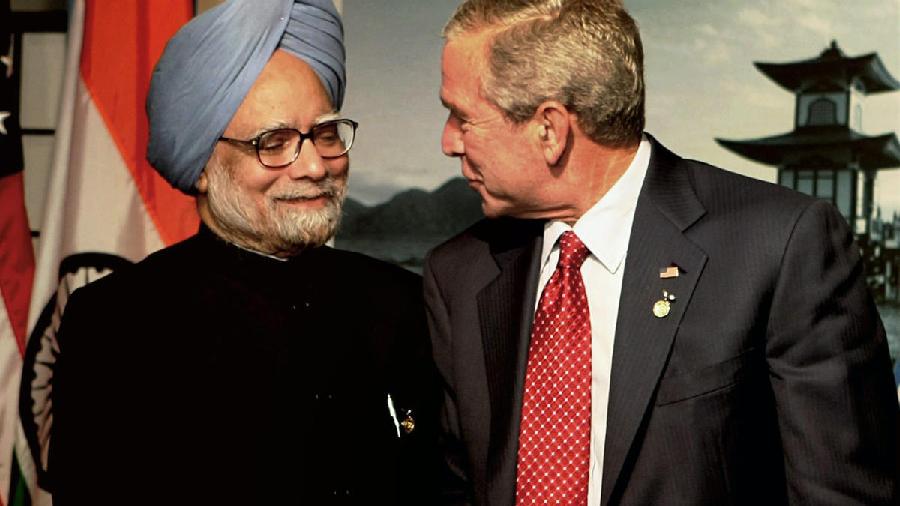Book: Friends With Benefits: The India-US Story
Written by: Seema Sirohi
Publisher: HarperCollins
Price: ₹699
Seema Sirohi’s book chronicles three decades of India-US ties, beginning with the early 1990s to the present. As an Indian journalist based in the United States of America, she had a ringside seat, though not with a complete view, as the Indo-US bilateral relationship shed the “hesitations of history” and moved to a wider, deeper, warmer but prickly partnership. Sirohi’s work details the ebb and flow of this transformation and the issues and the people involved in this process, especially in the US system and in India’s Washington Mission. She also brilliantly focuses on the perpetual intrusion of the two countries’ respective approaches towards, and ties with, Pakistan and China in their own bilateral interactions; these balancing acts are destined to continue.
Sirohi reached Washington as the US was savouring its unipolar moment after the Cold War. This was also the time India began to dismantle the license-quota raj under the former prime minister, P.V. Narasimha Rao. She captures how entrenched Cold War attitudes in both countries influenced bilateral ties through the 1990s. India had to deal with the US’s indifference to Pakistani terrorism and the challenges emanating from China. Bill Clinton’s administration, encouraged by US business interests, was focused on improving US-China relations. China could do no wrong.
India’s nuclear tests in 1998 enraged Clinton. Apart from imposing sanctions, he sought to “punish” India by joining hands with China to condemn the Indian tests. In the process, he overlooked China’s role in the development of Pakistan’s nuclear programme. Ironically, the nuclear tests led to the Jaswant Singh-Strobe Talbott talks which provided the first real engagement between the two countries. Sirohi’s account of how the “seeds” of the dialogue were “planted” in her house gives a significant, if brief, insight into how diplomacy works. Her description of the way Naresh Chandra, the then Indian ambassador in Washington, handled the Clinton administration’s negativity is an object lesson for diplomats even though Chandra was not a professional diplomat himself.
The Jaswant Singh-Strobe Talbott dialogue helped the US in understanding India’s security compulsions and also India’s potential for US business. However, as Sirohi demonstrates, the trajectory of the ties decisively moved upwards only under President George W. Bush. He became personally invested in the India relationship and ensured — actively and purposefully — that bureaucratic and political obstacles within the US system as well as international opposition were overcome to clear the path for India-US civil nuclear cooperation. This also led to greatly, but not completely, the doing away with dual-use, hi-tech denial regimes which targeted India. Bush found an able partner in the then prime minister, Manmohan Singh, who manoeuvred the Indian political system despite heading a coalition government, which relied on the support of communist parties to clinch the India-US nuclear deal in 2008. Sirohi brings great clarity to how this seminal agreement for bilateral ties was finally clinched.
In the past decade and a half, the visions and the actions of the prime ministers, Manmohan Singh and Narendra Modi, on the Indian side and those of the presidents, Barack Obama, Donald Trump and Joe Biden, in Washington have guided the overall relationship. Sirohi captures the interplay of their global and regional attitudes, their specific bilateral approaches, and the occasional frustrations because of the contradictions between them and how these impacted ties.
The agenda of the US and India in South Asia, especially on India’s western neighbourhood and in respect to China, could obviously never be identical, but with the US caught in the Afghan quagmire and its indecisiveness on how to handle China — a matter which it has not really resolved till now — complexities were added to the India-US ties. An enormous diplomatic effort was required in both countries to navigate the vastly different systems in the two nations to find common ground. Sirohi competently goes into the nitty-gritty of all it took, often through traversing the minefields of public emotion and the anguish of perceived neglect and broken assurances, to keep the relations moving upwards, including in the security and defence sectors.
Sirohi’s book would have benefitted from a more detailed consideration of the evolution of the Indian community and the extent of its actual impact on bilateral ties. All in all, Sirohi has made a major contribution to the literature on India-US relations both for scholars and the public.











